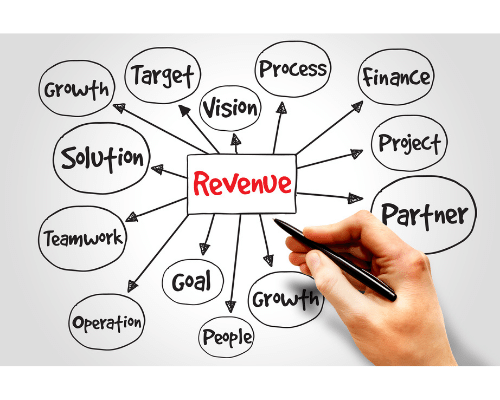People sometimes get confused when you talk about revenue operations. They might think it’s just another title for sales operations. In fact, there’s an important distinction between the two.
The Difference Between Sales Operations and Revenue Operations
Sales operations are designed to help sales teams run more efficiently. It aims to remove administrative tasks so that sales teams can close more deals (and close them more quickly). It takes on tasks such as:
- Platform and technology management
- Data management and forecasting
- Team organization
- Training and performance management
Sales operations is often just a part of the overall scope of revenue operations.
While there’s some cross-over between sales operations and revenue operations, revenue operations focuses on breaking down silos between departments. It aims to create alignment across an entire organization to increase revenue. It’s not just about sales but includes sales, marketing, finance, and customer support to address the entire customer lifecycle with an eye on revenue.
The Importance of Alignment

Aligning different departments, especially marketing and sales, is one of the keys to driving consistent revenue growth. Yet, most companies will tell you they don’t always feel that they’re aligned.
It’s not as easy as it sounds, either. Most companies have different goals for different departments and their performance is often judged in isolation. However, when they’re aligned, that’s where the magic can happen.
Marketing Alignment and Sales Alignment
When sales and marketing have a tight integration and align their goals, they see strong results.
- 38% higher sales win rates
- 36% higher customer retention rates
Marketing Alignment and Customer Service Alignment
When marketing and customer service are aligned, the results are powerful.
- 54% increase in customer satisfaction
- 4,900% increase in customer win-back rates
Wouldn’t you love to see these kinds of increases in your business?
A high-performing revenue operations organization focuses on three key areas to improve revenue generation by aligning resources using strategy, technology, and analytics.
Revenue Operations Strategy

This strategy is rather simple: get everyone focused on the activities that generate revenue. Making it happen is the difficult part.
Your revenue operations strategy should focus on getting everyone in your organization committed to the same common goals. It takes a careful analysis of the pipeline and what motivates prospects to act and connecting the sales signals.
While departments may have individual goals, they should all add up to the governing KPIs that drive your revenue growth. Lead value and conversion rates are important to everyone, but the data’s not also available across an organization. It takes a more transparent culture than many businesses are used to. That’s what it takes, however, to improve accountability, optimize results, and create more consistency in sales growth.
Revenue Operations Technology

The biggest challenge for companies – and one of the most significant reasons companies don’t have alignment – is that systems are often disconnected. For alignment, it’s important to centralize data so it’s accessible to the entire team. This requires a common platform and a common language.
It needs to track everything from the time a prospect enters a sales funnel to customer fulfillment to customer service. When the data is connected in a way that anyone that needs it can find it quickly and easily, things will improve every step of the way.
Revenue Operations Analytics

Alignment requires a shared vision across an organization. This means your KPIs have to be based on company revenue goals and not just department goals. For example, marketing goals may be based on engagement stats, such as unique visitors, time spent, and actions taken. Those metrics are important but what’s more significant is whether these actions ultimately led to sales.
Analytics that connect the dots and track the entire customer journey are essential to determine what’s really working. Lead generation is only successful when it leads to qualified sales leads that convert to actual sales.
FounderScale Can Help Improve Revenue Operations
As a HubSpot solution partner, we’ve found that HubSpot’s tools can greatly help align your organization. As you know, however, it’s not just technology that makes things work, it’s the way tech is integrated and used. That’s where we come in.
FounderScale helps founder-led B2B businesses increase sales by improving the revenue operations process with a comprehensive approach to pipeline management. We help businesses maximize their ROI. As a sales-first B2B agency, we can reduce your burden, help you scale, and create a sales engine that provides sustainable growth.
Contact FounderScale today and let us help you grow your business.
How to Increase B2B Sales Engagement by 667%
 Engaging people on a human-to-human level to provide experiences and education is one of the few long-term sustainable lead generation methods that you can employ. Many other methods like contact and pitch may provide a certain level of results but the efficiency and cost are less than ideal. To maximize sales engagement platforms, you have a number of different options ranging from webinars to group lunch and learns which provide 667% higher engagement than cold outreach to set a meeting.
Engaging people on a human-to-human level to provide experiences and education is one of the few long-term sustainable lead generation methods that you can employ. Many other methods like contact and pitch may provide a certain level of results but the efficiency and cost are less than ideal. To maximize sales engagement platforms, you have a number of different options ranging from webinars to group lunch and learns which provide 667% higher engagement than cold outreach to set a meeting.
Read our new mini-book to learn real-world strategies to boost sales engagement by 667%.



